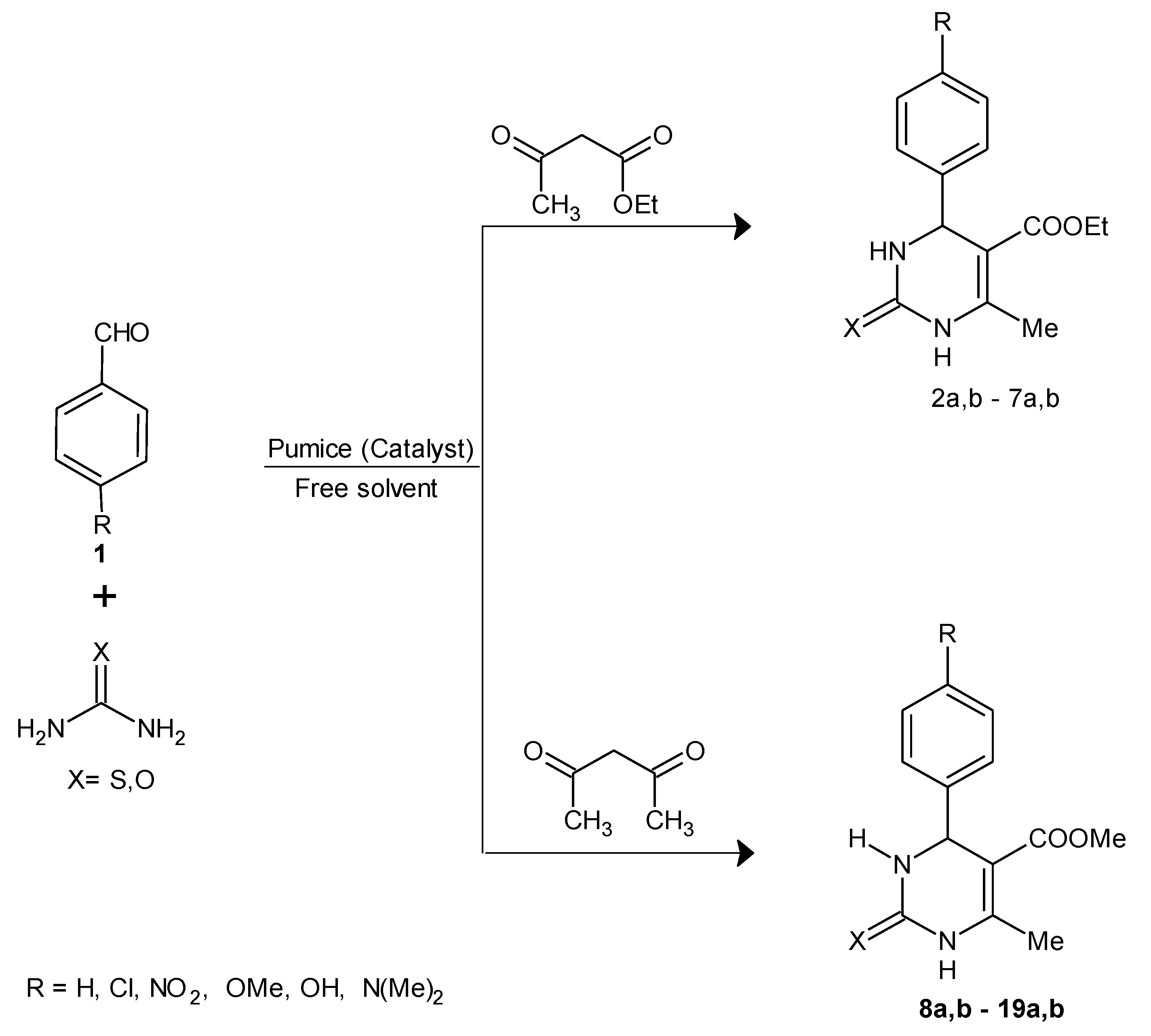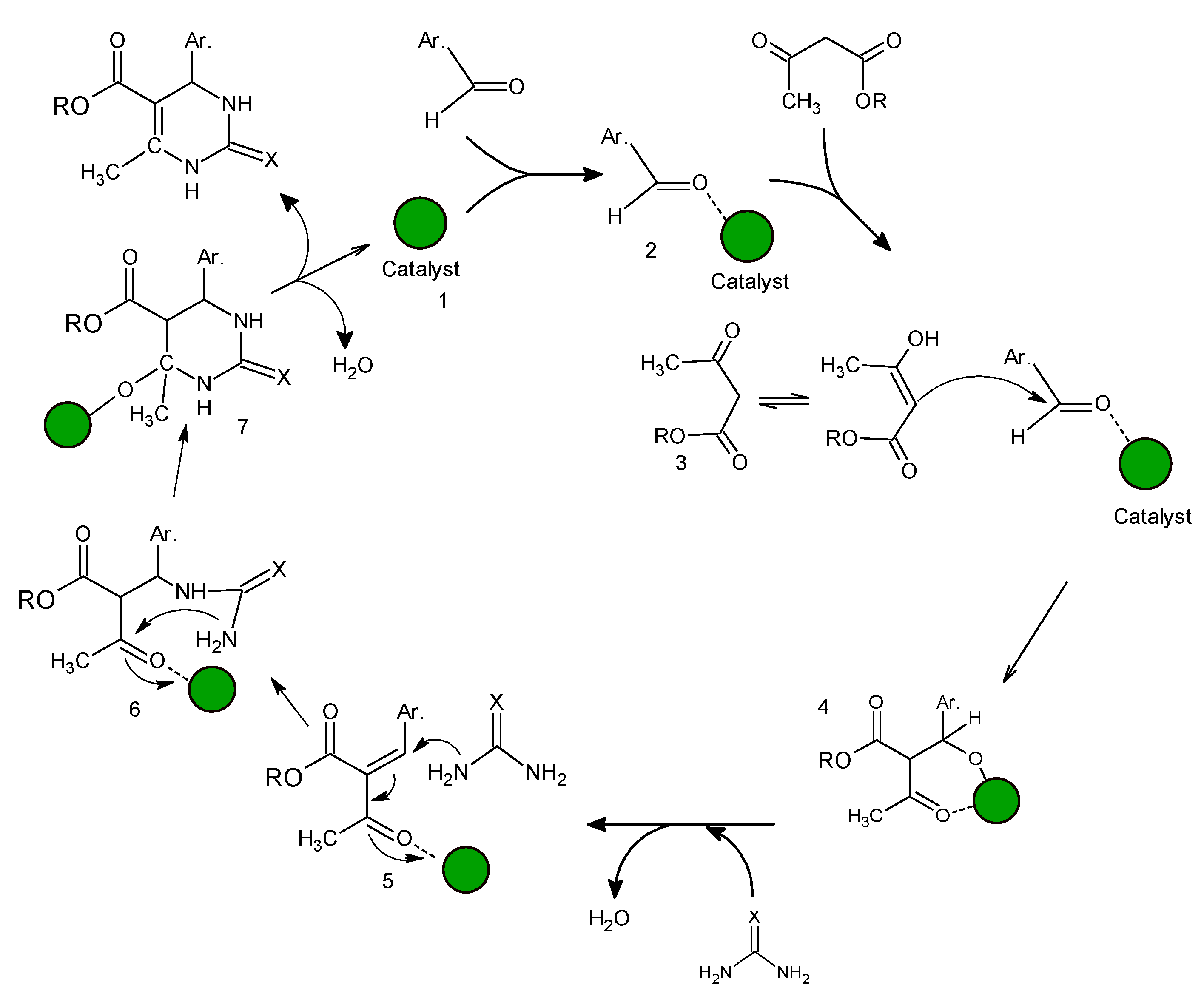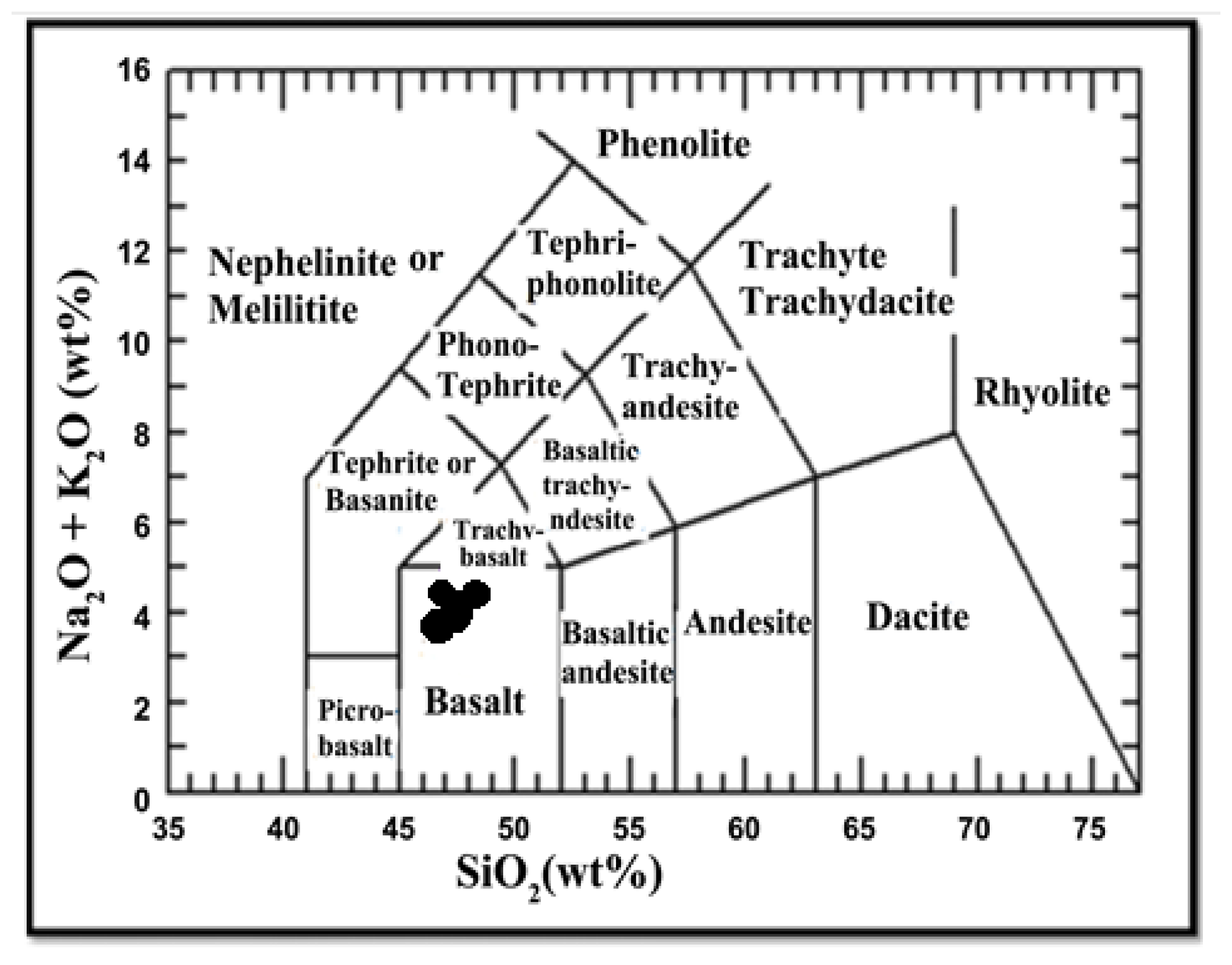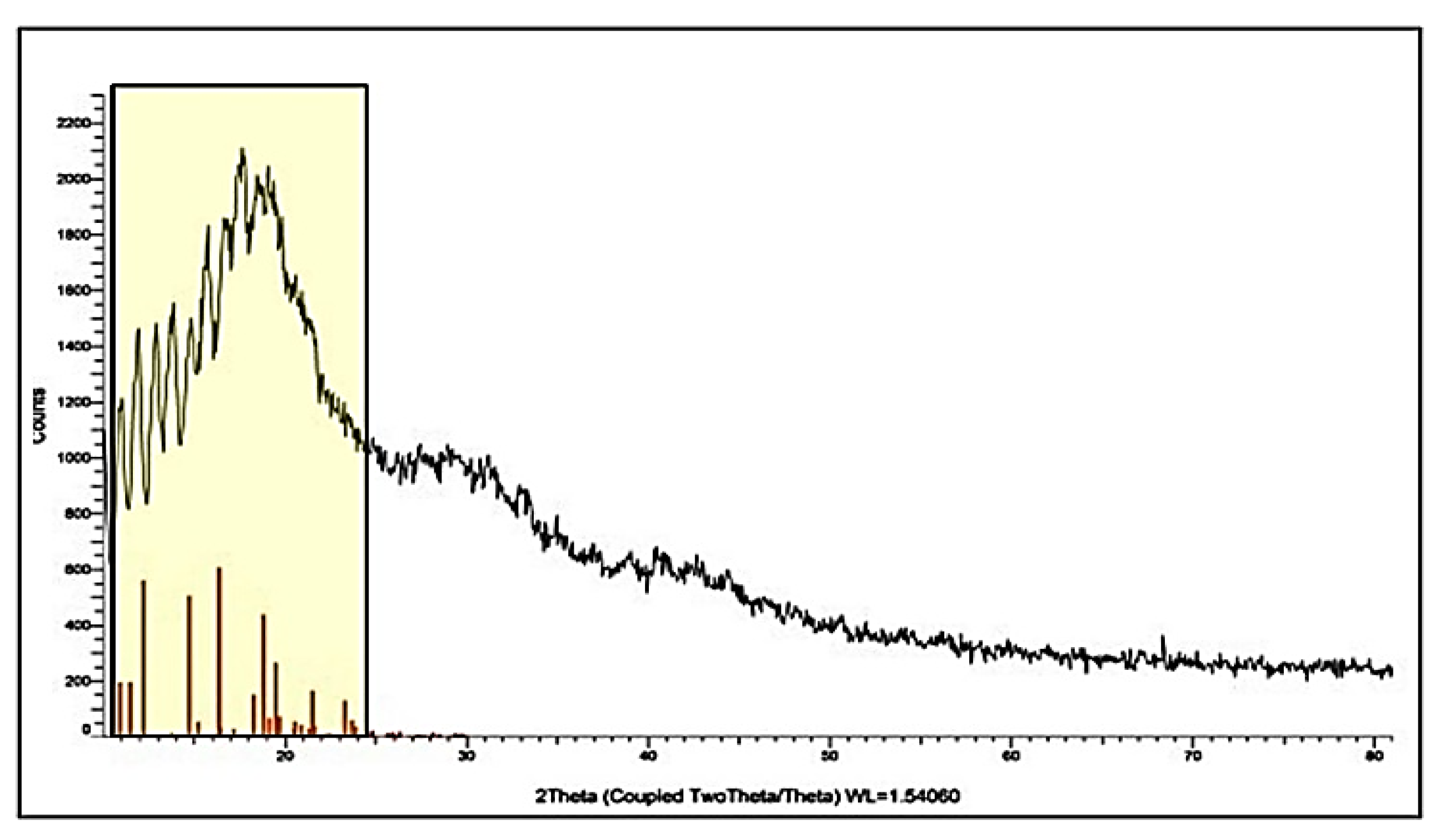Pumice as a Novel Natural Heterogeneous Catalyst for the Designation of 3,4-Dihydropyrimidine-2-(1H)-ones/thiones under Solvent-Free Conditions
Abstract
:1. Introduction
2. Experimental
2.1. General Procedure for Synthesis of 3,4-Dihydropyrimidine-2(1H)-ones/thiones 2a,b–19a,b
2.1.1. Ethyl 6-methyl-2-oxo-4-phenyl-1,2,3,4-tetrahydropyrimidine-5-carboxylate (2a)
2.1.2. Ethyl 4-(4-chlorophenyl)-6-methyl-2-oxo-1,2,3,4-tetrahydropyrimidine-5-carboxylate (3a)
2.1.3. Ethyl 6-methyl-4-(4-nitrophenyl)-2-oxo-1,2,3,4-tetrahydropyrimidine-5-carboxylate (4a)
2.1.4. Ethyl 4-(4-methoxyphenyl)-6-methyl-2-oxo-1,2,3,4-tetrahydropyrimidine-5-carboxylate (5a)
2.1.5. Ethyl 4-[4-(dimethylamino)phenyl]-6-methyl-2-oxo-1,2,3,4-tetrahydropyrimidine-5-carboxylate (6a)
2.1.6. Ethyl 4-(4-hydroxyphenyl)-6-methyl-2-oxo-1,2,3,4-tetrahydropyrimidine-5-carboxylate (7a)
2.1.7. Ethyl 6-methyl-4-phenyl-2-thioxo-1,2,3,4-tetrahydropyrimidine-5-carboxylate (2b)
2.1.8. Ethyl 4-(4-chlorophenyl)-6-methyl-2-thioxo-1,2,3,4-tetrahydropyrimidine-5-carboxylate (3b)
2.1.9. Ethyl 6-methyl-4-(4-nitrophenyl)-2-thioxo-1,2,3,4-tetrahydropyrimidine-5-carboxylate (4b)
2.1.10. Ethyl 4-(4-methoxyphenyl)-6-methyl-2-thioxo-1,2,3,4-tetrahydropyrimidine-5-carboxylate (5b)
2.1.11. Ethyl 4-[4-(dimethylamino)phenyl]-6-methyl-2-thioxo-1,2,3,4-tetrahydropyrimidine-5-carboxylate (6b)
2.1.12. Ethyl 4-(4-hydroxyphenyl)-6-methyl-2-thioxo-1,2,3,4-tetrahydropyrimidine-5-carboxylate (7b)
2.1.13. Methyl 6-methyl-2-oxo-4-phenyl-1,2,3,4-tetrahydropyrimidine-5-carboxylate (8a)
2.1.14. Methyl 4-(4-chlorophenyl)-6-methyl-2-oxo-1,2,3,4-tetrahydropyrimidine-5-carboxylate (9a)
2.1.15. Methyl 6-methyl-4-(4-nitrophenyl)-2-oxo-1,2,3,4-tetrahydropyrimidine-5-carboxylate (10a)
2.1.16. Methyl 4-(4-methoxyphenyl)-6-methyl-2-oxo-1,2,3,4-tetrahydropyrimidine-5-carboxylate (11a)
2.1.17. Methyl 4-[4-(dimethylamino)phenyl]-6-methyl-2-oxo-1,2,3,4-tetrahydropyrimidine-5-carboxylate (12a)
2.1.18. Methyl 4-(4-hydroxyphenyl)-6-methyl-2-oxo-1,2,3,4-tetrahydropyrimidine-5-carboxylate (13a)
2.1.19. Methyl 6-methyl-4-phenyl-2-thioxo-1,2,3,4-tetrahydropyrimidine-5-carboxylate (14b)
2.1.20. Methyl 4-(4-chlorophenyl)-6-methyl-2-thioxo-1,2,3,4-tetrahydropyrimidine-5-carboxylate (15b)
2.1.21. Methyl 6-methyl-4-(4-nitrophenyl)-2-thioxo-1,2,3,4-tetrahydropyrimidine-5-carboxylate (16b)
2.1.22. Methyl 4-(4-methoxyphenyl)-6-methyl-2-thioxo-1,2,3,4-tetrahydropyrimidine-5-carboxylate (17b)
2.1.23. Methyl 4-[4-(dimethylamino)phenyl]-6-methyl-2-thioxo-1,2,3,4-tetrahydropyrimidine-5-carboxylate (18b)
2.1.24. Methyl 4-(4-hydroxyphenyl)-6-methyl-2-thioxo-1,2,3,4-tetrahydropyrimidine-5-carboxylate (19b)
2.2. Pumice Sampling and Sample Preparation
3. Results and Discussion
3.1. Chemistry
3.2. Characterization of Pumice Samples
3.2.1. The Chemical Composition
3.2.2. X-ray Diffraction
3.2.3. Physical Parameters
4. Conclusions
Supplementary Materials
Author Contributions
Funding
Institutional Review Board Statement
Informed Consent Statement
Data Availability Statement
Acknowledgments
Conflicts of Interest
References
- Amer, A.A.; Abdelhamid, A.A. One-Pot Multicomponent Synthesis of Some New Cyanopyridines. J. Heterocycl. Chem. 2017, 54, 3126–3132. [Google Scholar] [CrossRef]
- Mohamed, S.K.; Simpson, J.; Marzouk, A.A.; Talybov, A.H.; Abdelhamid, A.A.; Abdullayev, Y.A.; Abbasov, V.M. Multicomponent green synthesis, spectroscopic and structural investigation of multi-substituted imidazoles. Part 1. Z. Für Nat. B 2015, 70, 809–817. [Google Scholar] [CrossRef]
- Khalaf, M.M.; Abdelhamid, A.A. Sol–gel derived mixed oxide zirconia: Titania green heterogeneous catalysts and their performance in acridine derivatives synthesis. Catal. Lett. 2016, 146, 645–655. [Google Scholar] [CrossRef]
- Khalilov, A.N.; Abdelhamid, A.A.; Gurbanov, A.V.; Ng, S.W. 9-(5-Bromo-2-hydroxyphenyl)-10-(2-hydroxypropyl)-3, 3, 6, 6-tetramethyl-1, 2, 3, 4, 5, 6, 7, 8, 9, 10-decahydroacridine-1, 8-dione. Acta Crystallogr. E 2011, 67, o1146. [Google Scholar] [CrossRef]
- Khodairy, A.; Ali, A.M.; El-Wassimy, M.T. Synthesis of Novel Chromene, Pyridine, Pyrazole, Pyrimidine, and Imidazole Derivatives via One-pot Multicomponent Reaction. J. Heterocycl. Chem. 2017, 54, 3342–3349. [Google Scholar] [CrossRef]
- Bruckmann, A.; Krebs, A.; Bolm, C. Organocatalytic reactions: Effects of ball milling, microwave and ultrasound irradiation. Green Chem. 2008, 10, 1131–1141. [Google Scholar] [CrossRef]
- Rodríguez, B.; Bruckmann, A.; Rantanen, T.; Bolm, C. Solvent-free carbon-carbon bond formations in ball mills. Adv. Synth. Catal. 2007, 349, 2213–2233. [Google Scholar] [CrossRef]
- Raston, C.L.; Scott, J.L. Chemoselective, solvent-free aldol condensation reaction. Green Chem. 2000, 2, 49–52. [Google Scholar] [CrossRef]
- Shan, Z.-X.; Luo, X.-X.; Hu, L.; Hu, X.-Y. New observation on a class of old reactions: Chemoselectivity for the solvent-free reaction of aromatic aldehydes with alkylketones catalyzed by a double-component inorganic base system. Sci. China Chem. 2010, 53, 1095–1101. [Google Scholar] [CrossRef]
- Tanaka, K.; Toda, F.K. Solvent-free organic synthesis. Chem. Rev. 2000, 100, 1025–1074. [Google Scholar] [CrossRef]
- Schmeyers, J.; Toda, F.; Boy, J.; Kaupp, G. Quantitative solid–solid synthesis of azomethines. J. Chem. Soc. Perkin Trans. 1998, 2, 989–994. [Google Scholar] [CrossRef]
- Atwal, K.S.; Swanson, B.N.; Unger, S.E.; Floyd, D.M.; Moreland, S.; Hedberg, A.; Reilly, B.C. Dihydropyrimidine calcium channel blockers. 3. 3-Carbamoyl-4-aryl-1, 2, 3, 4-tetrahydro-6-methyl-5-pyrimidinecarboxylic acid esters as orally effective antihypertensive agents. J. Med. Chem. 1991, 34, 806–811. [Google Scholar] [CrossRef] [PubMed]
- Kappe, C.O. Biologically active dihydropyrimidones of the Biginelli-type—a literature survey. Eur. J. Med. Chem. 2000, 35, 1043–1052. [Google Scholar] [CrossRef]
- Brands, M.; Endermann, R.; Gahlmann, R.; Kruger, J.; Raddatz, S. Dihydropyrimidinones—A new class of anti-staphylococcal antibiotics. Bioorg. Med. Chem. Lett. 2003, 13, 241–245. [Google Scholar] [CrossRef]
- Peng, J.; Deng, Y. Ionic liquids catalyzed Biginelli reaction under solvent-free conditions. Tetrahedron Lett. 2001, 42, 5917–5919. [Google Scholar] [CrossRef]
- Arfan, A.; Paquin, L.; Bazureau, J.P. Acidic task-specific ionic liquid as catalyst of microwave-assisted solvent-free Biginelli reaction. Russ. J. Org. Chem. 2007, 43, 1058–1064. [Google Scholar] [CrossRef]
- Ahmed, E.A.; Mohamed, M.A.; El-Saghier, A.M. One-pot synthesis of dihydropyrimidin-2 (1H)-ones catalyzed by ceric (IV) ammonium nitrate (CAN) under solvent free conditions. J. Am. Sci. 2012, 8, 815–818. [Google Scholar]
- Adibi, H.; Samimi, H.A.; Beygzadeh, M. Iron (III) trifluoroacetate and trifluoromethanesulfonate: Recyclable Lewis acid catalysts for one-pot synthesis of 3, 4-dihydropyrimidinones or their sulfur analogues and 1, 4-dihydropyridines via solvent-free Biginelli and Hantzsch condensation protocols. Catal. Commun 2007, 8, 2119–2124. [Google Scholar] [CrossRef]
- Ma, Y.; Qian, C.; Wang, L.; Yang, M. Lanthanide triflate catalyzed Biginelli reaction. One-pot synthesis of dihydropyrimidinones under solvent-free conditions. J. Org. Chem. 2000, 65, 3864–3868. [Google Scholar] [CrossRef]
- Phukan, M.; Kalita, M.K.; Borah, R. A new protocol for Biginelli (or like) reaction under solvent-free grinding method using Fe (NO3) 3.9 H2O as catalyst. Green Chem. Lett. Rev. 2010, 3, 329–334. [Google Scholar] [CrossRef]
- Su, W.; Li, J.; Zheng, Z.; Shen, Y. One-pot synthesis of dihydropyrimidiones catalyzed by strontium (II) triflate under solvent-free conditions. Tetrahedron Lett. 2005, 46, 6037–6040. [Google Scholar] [CrossRef]
- Yilai Jiao, X.F. Porous Materials for Catalysis: Toward Sustainable Synthesis and Applications of Zeolites. In Sustainable Nanoscale Engineering from Materials Design to Chemical Processing, 1st ed.; Elsevier: Amsterdam, The Netherlands, 2020; pp. 115–137. [Google Scholar]
- Qiao, Z.A.; Huo, Q. Synthetic Chemistry of the Inorganic Ordered Porous Materials. In Modern Inorganic Synthetic Chemistry; Elsevier: Amsterdam, The Netherlands, 2011; pp. 339–373. [Google Scholar]
- Liu, P.S.; Chen, G.F. General introduction to porous materials Porous Materials. In Porous Materials, 1st ed.; Butterworth-Heinemann: Boston, MA, USA, 2014; pp. 1–20. [Google Scholar]
- Sepehr, M.N.; Zarrabi, M.; Kazemian, H.; Amrane, A.; Yaghmaian, K.; Ghaffari, H.R. Removal of hardness agents, calcium and magnesium, by natural and alkaline modified pumice stones in single and binary systems. Appl. Surf. Sci. 2013, 274, 295–305. [Google Scholar] [CrossRef]
- Tapan, M.; Yalçın, Z.; İçelli, O.; Kara, H.; Orak, S.; Özvan, A.; Depci, T. Effect of physical, chemical and electro-kinetic properties of pumice samples on radiation shielding properties of pumice material. Ann. Nucl. Energy 2014, 65, 290–298. [Google Scholar] [CrossRef]
- Al-Naaymi, T.A.; Ali, M.A. Chemical physical and geotechnical properties comparison between scoria and pumice deposits in Dhamar—Rada volcanic field—SW Yemen. Aust. J. Basic Appl. Sci. 2013, 7, 116–124. [Google Scholar]
- Ottanà, R.; Saija, L.M.; Burriesci, N.; Giordano, N. Hydrothermal synthesis of zeolites from pumice in alkaline and saline environment. Zeolites 1982, 2, 295–298. [Google Scholar] [CrossRef]
- Dharma Rao, G.B.; Acharya, B.N.; Verma, S.K.; Kaushik, M.P. N,N′-Dichlorobis (2, 4, 6-trichlorophenyl) urea (CC-2) as a new reagent for the synthesis of pyrimidone and pyrimidine derivatives via Biginelli reaction. Tetrahedron Lett. 2011, 52, 809–812. [Google Scholar]
- Dharma Rao, G.B.; Acharya, B.N.; Kaushik, M.P. An efficient synthesis of β-ketoesters via transesterification and its application in Biginelli reaction under solvent-free, catalyst-free conditions. Tetrahedron Lett. 2013, 54, 6644–6647. [Google Scholar] [CrossRef]
- Lawrence, M.A.; David, R.C. Characterization and Analysis of Porosity and Pore Structures. Rev. Mineral. Geochem. 2015, 80, 61–164. [Google Scholar]
- Whitham, A.G.; Sparks, R.S.J. Pumice. Bull. Volcanol. 1986, 48, 209–223. [Google Scholar] [CrossRef]
- Tamaddon, F.; Razmi, Z.; Jafari, A.A. Synthesis of 3, 4-dihydropyrimidin-2 (1H)-ones and 1, 4-dihydropyridines using ammonium carbonate in water. Tetrahedron Lett. 2010, 51, 1187–1189. [Google Scholar] [CrossRef]
- Yadav, J.S.; Kumar, S.P.; Kondaji, G.; Rao, R.S.; Nagaiah, K. A novel l-proline catalyzed Biginelli reaction: One-pot synthesis of 3, 4-dihydropyrimidin-2 (1 H)-ones under solvent-free conditions. Chem. Lett. 2004, 33, 1168–1169. [Google Scholar] [CrossRef]
- Khaskel, A.; Gogoi, P.; Barman, P.; Bandyopadhyay, B. Grindstone chemistry: A highly efficient and green method for synthesis of 3, 4-dihydropyrimidin-2-(1 H)-ones by l-tyrosine as an organocatalyst: A combined experimental and DFT study. RSC Adv. 2014, 4, 35559–35567. [Google Scholar] [CrossRef]
- Safari, J.; Gandomi-Ravandi, S. Carbon nanotubes supported by titanium dioxide nanoparticles as recyclable and green catalyst for mild synthesis of dihydropyrimidinones/thiones. J. Mol. Struct. 2014, 1065, 241–247. [Google Scholar] [CrossRef]
- Jetti, S.R.; Bhatewara, A.; Kadre, T.; Jain, S. Silica-bonded N-propyl sulfamic acid as an efficient recyclable catalyst for the synthesis of 3, 4-dihydropyrimidin-2-(1H)-ones/thiones under heterogeneous conditions. Chin. Chem. Lett. 2014, 25, 469–473. [Google Scholar] [CrossRef]
- Shirini, F.; Abedini, M.; Pourhasan-Kisomi, R. N-Sulfonic acid poly (4-vinylpyridinium) chloride as a highly efficient and reusable catalyst for the Biginelli reaction. Chin. Chem. Lett. 2014, 25, 111–114. [Google Scholar] [CrossRef]
- Sandeep, P.; Prashant, B.; Murlidhar, P.; Wadekarb, S. Simple and efficient synthesis of 3,4-dihydropyrimidin-2(1H)-thiones utilizing l-proline nitrate as a proficient, recyclable and eco-friendly catalyst. J. Saudi Chem. Soc. 2017, 21, 415–419. [Google Scholar] [CrossRef]
- Cepanec, I.; Litvić, M.; Filipan-Litvić, M.; Grüngold, I. Antimony (III) chloride-catalysed Biginelli reaction: A versatile method for the synthesis of dihydropyrimidinones through a different reaction mechanism. Tetrahedron 2007, 63, 11822–11827. [Google Scholar] [CrossRef]
- Sibous, S.; Said, B.; Rachid, G.; Nouzha, H.; Amina, H. Easy synthesis of 3, 4-dihydropyrimidin-2-(1H)-ones using phosphate fertilizers MAP, DAP AND TSP as efficient catalysts. J. Turkish Chem. Soc. 2017, 4, 477. [Google Scholar] [CrossRef]
- Abhishek, N.; Vaibhav, K.; Dipak, K. A facile approach for the synthesis of 3, 4-dihydropyrimidin-2-(1H)-ones using a microwave promoted Biginelli protocol in ionic liquid. J. Chem. Sci. 2012, 124, 921–926. [Google Scholar]
- Suresh, P.; Swati, D.; Sanjeevani, Y. Pineapple juice as a natural catalyst for Biginelli reaction. Int. J. Org. Chem. 2011, 1, 125–131. [Google Scholar]
- Khalaf, E.A.; Abdel Motelib, A.; Hammed, M.S.; El Manawi, A.H. Volcano-sedimentary characteristics in the Abu Treifiya Basin, Cairo-Suez District, Egypt: Example of dynamics and fluidization over sedimentary and volcaniclastic beds by emplacement of syn-volcanic basaltic rocks. J. Volcanol. Geotherm. 2015, 1–28. [Google Scholar] [CrossRef]
- Lebas, M.J.; Lemaitre, R.W.; Streckeisen, A.; Zanettin, B. A chemical classification of volcanic rocks based on the total alkali-silica diagram. J. Petrol. 1986, 27, 745–750. [Google Scholar]
- Marantos, I.; Christidis, G.E.; Ulmanu, M. Zeolite formation and deposits. Handb. Nat. Zeolites 2011, 28–51. [Google Scholar] [CrossRef] [Green Version]
- Mansouri, N.; Rikhtegar, N.; Ahmad Panahi, H.; Atabi, F. Porosity, Characterization and Structural Properties of Natural Zeolite-Clinoptilolite as a Sorbent. Environ. Prot. Eng. 2013, 39, 139. [Google Scholar]
- Baerlocher, C.; McCusker, L.B.; Olson, D.H. Compendium of zeolite framework types: Building schemes and type characteristics. In Atlas of Zeolite Structure Types, 6th ed.; Elsevier: Amsterdam, The Netherlands, 2007. [Google Scholar]







| Compound | Amount of Pumice | ||||||
|---|---|---|---|---|---|---|---|
| 0.1 g | 0.2g | 0.3 g | 0.4 g | 0.5 g | |||
| Yield | Conversion % a | Selectivity % b | |||||
| 2a | 58% | 86% | 93% | 98% | 98% | 88 | 89.6 |
| 3a | 53% | 82% | 95% | 98% | 98% | 89.2 | 91 |
| 4a | 61% | 89% | 92% | 97% | 97% | 89.5 | 92.2 |
| 5a | 57% | 81% | 97% | 97% | 97% | 89 | 91.7 |
| 6a | 64% | 92% | 98% | 98% | 98% | 76.7 | 78.3 |
| 7a | 48% | 85% | 91% | 98% | 98% | 88.4 | 90.2 |
| 2b | 70% | 90% | 96% | 98% | 98% | 88.5 | 90.3 |
| 3b | 56% | 91% | 95% | 96% | 96% | 89.6 | 93.3 |
| 4b | 63% | 93% | 94% | 98% | 98% | 90 | 91.7 |
| 5b | 72% | 90% | 97% | 97% | 97% | 89.5 | 92.3 |
| 6b | 61% | 87% | 96% | 98% | 98% | 89.8 | 91.7 |
| 7b | 58% | 89% | 95% | 98% | 98% | 89.1 | 90.8 |
| 8a | 72% | 93% | 97% | 97% | 97% | 92.5 | 95.4 |
| 9a | 60% | 92% | 97% | 98% | 98% | 93.3 | 95.3 |
| 10a | 59% | 90% | 96% | 96% | 96% | 93.5 | 97.5 |
| 11a | 55% | 91% | 97% | 98% | 98% | 93.2 | 95.2 |
| 12a | 71% | 89% | 97% | 97% | 97% | 93.5 | 96.4 |
| 13a | 73% | 85% | 92% | 96% | 96% | 92.8 | 96.8 |
| 14b | 51% | 86% | 97% | 98% | 98% | 93 | 94.8 |
| 15b | 58% | 89% | 94% | 98% | 98% | 93.7 | 95.6 |
| 16b | 59% | 76% | 89% | 97% | 97% | 93.8 | 96.7 |
| 17b | 67% | 88% | 96% | 98% | 98% | 93.6 | 95.5 |
| 18b | 68% | 90% | 94% | 96% | 96% | 93.8 | 97.7 |
| 19b | 60% | 84% | 92% | 97% | 97% | 96.3 | 99.3 |
| Entry | X | Y | M.P. | Reported | |
|---|---|---|---|---|---|
| 2a | OEt | O | H | 202 | 201–202 [33] |
| 3a | OEt | O | Cl | 211 | 212–214 [34] |
| 4a | OEt | O | NO2 | 209 | 209–210 [33] |
| 5a | OEt | O | OMe | 201 | 201–202 [33] |
| 6a | OEt | O | N(Me)2 | 233 | 231–232 [33] |
| 7a | OEt | O | OH | 232 | 232–234 [34] |
| 2b | OEt | S | H | 208 | 207–209 [35] |
| 3b | OEt | S | Cl | 194 | 192–194 [36] |
| 4b | OEt | S | NO2 | 207 | 207–208 [37] |
| 5b | OEt | S | OMe | 153 | 150–151 [34] |
| 6b | OEt | S | N(Me)2 | 209 | 208–209 [33] |
| 7b | OEt | S | OH | 203 | 202–203 [33] |
| 8a | OMe | O | H | 228 | 232–234 [33] |
| 9a | OMe | O | Cl | 224 | 224–226 [35] |
| 10a | OMe | O | NO2 | 236 | 236–238 [36] |
| 11a | OMe | O | OMe | 173 | 172 [37] |
| 12a | OMe | O | N(Me)2 | 215 | 220 [38] |
| 13a | OMe | O | OH | 256 | 256 [39] |
| 14b | OMe | S | H | 228 | 228–230 [40] |
| 15b | OMe | S | Cl | 209 | 201 [41] |
| 16b | OMe | S | NO2 | 213 | 212 [41] |
| 17b | OMe | S | OMe | 201 | 202 [41] |
| 18b | OMe | S | N(Me)2 | 179 | 180 [42] |
| 19b | OMe | S | OH | 253 | 251–252 [43] |
| SiO2 | Al2O3 | MgO | Na2O | CaO | Fe2O3 | K2O | TiO2 | MnO | L.O.I | Total |
|---|---|---|---|---|---|---|---|---|---|---|
| 48.89 | 13.90 | 7.34 | 3.08 | 9.70 | 7.71 | 1.84 | 1.01 | 0.15 | 5.70 | 99.321 |
| 49.10 | 15.00 | 6.20 | 2.50 | 9.10 | 8.20 | 2.30 | 0.95 | 0.16 | 6.00 | 99.51 |
| 49.50 | 14.10 | 7.40 | 2.70 | 9.80 | 7.90 | 1.70 | 0.84 | 0.16 | 5.20 | 99.302 |
| 49.30 | 14.50 | 6.90 | 2.20 | 9.30 | 8.70 | 2.50 | 0.69 | 0.17 | 4.60 | 98.865 |
| No. | Bulk Porosity (%) | Average Pore Size nm | Average Pore Volume cm2 g−1 | Average Surface Area |
|---|---|---|---|---|
| 1 | 78.2 | 38.892 | 0.00661 | 0.6801 |
| 2 | 79.5 | 33.401 | 0.00631 | 0.7475 |
| 3 | 78.5 | 40.051 | 0.00531 | 0.05301 |
| 4 | 81.4 | 64.501 | 0.00551 | 0.4201 |
| 5 | 83.9 | 21.121 | 0.00781 | 1.47701 |
Publisher’s Note: MDPI stays neutral with regard to jurisdictional claims in published maps and institutional affiliations. |
© 2022 by the authors. Licensee MDPI, Basel, Switzerland. This article is an open access article distributed under the terms and conditions of the Creative Commons Attribution (CC BY) license (https://creativecommons.org/licenses/by/4.0/).
Share and Cite
El-Lateef, H.M.A.; Gouda, M.; Khalaf, M.M.; Shaaban, S.; Elkanzi, N.A.A.; Saber, E.S.A.; Abdelhamid, A.A.; Ali, A.M. Pumice as a Novel Natural Heterogeneous Catalyst for the Designation of 3,4-Dihydropyrimidine-2-(1H)-ones/thiones under Solvent-Free Conditions. Molecules 2022, 27, 6044. https://doi.org/10.3390/molecules27186044
El-Lateef HMA, Gouda M, Khalaf MM, Shaaban S, Elkanzi NAA, Saber ESA, Abdelhamid AA, Ali AM. Pumice as a Novel Natural Heterogeneous Catalyst for the Designation of 3,4-Dihydropyrimidine-2-(1H)-ones/thiones under Solvent-Free Conditions. Molecules. 2022; 27(18):6044. https://doi.org/10.3390/molecules27186044
Chicago/Turabian StyleEl-Lateef, Hany M. Abd, Mohamed Gouda, Mai M. Khalaf, Saad Shaaban, Nadia A. A. Elkanzi, El Sayed A. Saber, Antar A. Abdelhamid, and Ali M. Ali. 2022. "Pumice as a Novel Natural Heterogeneous Catalyst for the Designation of 3,4-Dihydropyrimidine-2-(1H)-ones/thiones under Solvent-Free Conditions" Molecules 27, no. 18: 6044. https://doi.org/10.3390/molecules27186044








